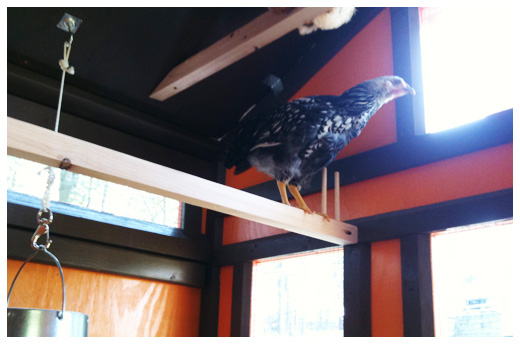 by guest blogger Leah Zerbe, online editor for Rodale.com
by guest blogger Leah Zerbe, online editor for Rodale.com
All over the United States, people are opening their lawns and gardens to dinosaurs, allowing them to peck at pests, feast on weed seeds, and slurp down blades of grass like spaghetti.
I myself have about 80 dinosaurs running around the pastures of my family farm.
When I first learned of the connection between dinosaurs and chickens, I was intrigued. So I checked in with some top dinosaur scientists to get the scoop. “Chickens are dinosaurs. It’s not that they’re closely related—they are actual dinosaurs,” explains Ken Lacovara, PhD, associate professor of geology and paleontology at Drexel University. “One lineage of dinosaurs survived the mass extinction 65 million years ago, the birds. So every living bird, from a parakeet to a penguin, is literally a dinosaur.”
OK, so all modern birds are technically dinosaurs. “But of all modern birds, chickens are among the most ‘primitive’ or ‘dinosaurlike,'” paleontologist Matthew C. Lamanna, PhD, assistant curator at the Carnegie Museum of Natural History in Pittsburgh, told me, noting that chickens and other familiar birds like geese and ducks belong to an evolutionary lineage known as Galloanserae. In fact, scientists have found at least one species belonging to this Galloanserae lineage—a ducklike bird from Antarctica called Vegavis iaai—in rocks that date to the Mesozoic Era, aka the Age of the Dinosaurs. “So, although today’s chicken species certainly didn’t evolve until much later, its lineage can be traced all the way back to the time of Tyrannosaurus rex,” Lamanna explains.
Lacovara sees the connection firsthand. When he’s not studying dinosaurs in his Drexel lab, he and his wife and son enjoy watching their flock of seven heritage-breed chickens forage about in their backyard in South Jersey, studying the habits of their Buff Orpington, Australorp, Leghorn, and even Miss Frenchy, the friendly French Faverolle, among others. “You see features. It doesn’t take a lot of imagination to see a T. rex in a chicken,” he says. “When they run across the yard, in my mind’s eye, I’m seeing a pack of velociraptors running across a yard.”
Chickens have the same keen vision as the dinosaurs in history books, including very strong color vision. Anatomically speaking, there are very few differences between chickens and certain types of dinosaurs. And although scientists aren’t completely sure what sounds dinosaurs made, if you’ve ever tried to lift a broody hen off of her eggs, well, the scolding you get sounds primitive, prehistoric.
Certain dinosaurs apparently sat on their nests brooding their eggs and hatchlings in much the same way modern chickens do, too. K. Christopher Beard, PhD, curator and Mary R. Dawson Chair of Vertebrate Paleontology at the Carnegie Museum of Natural History, filled me in on the famous enlightening discovery that took place in Mongolia 10 to 15 years ago, when scientists recovered what remained of a mother oviraptorosaur guarding her nest. “Apparently, the animal died in a massive sandstorm in the Gobi Desert, but she refused to abandon her nest and offspring,” Beard says. “Instead, she and her offspring were buried under a shifting sand dune, thus preserved as fossils for millions of years.”
I loved hearing stories like this. It struck a chord, creating some sort of connection to an era long gone. “Humanity is tied directly to the rest of the animal kingdom by our evolutionary heritage. If you go back far enough in time, we shared a common ancestor with an increasing array of other organisms, with whom we share the earth today,” says Beard.
The good news for humans is that we can understand basic facts about human biology, such as how to treat various diseases, by studying other animals (like lab rats) that are only distantly related to us, Beard notes.
“The flip side of this is that we should probably think a little differently about the rest of life on Earth. Other species of animals are related to us in the same way that our first
cousins are related to us—we share a common ancestor,” Beard says. “The only difference is one of degree, not of kind.”
 Leah Zerbe is online editor for Rodale.com. Prior to working at Rodale, she was the senior online editor at NBCPhiladelphia.com, where she headed up the station’s online “Going Green” initiative, wrote about center city crime and traffic jams, and blogged about her beloved Philadelphia Phillies. She and her husband run a sustainable organic farm in Schuylkill County where they grow vegetables, strawberries, herbs, and flowers, and raise heritage breed chickens.
Leah Zerbe is online editor for Rodale.com. Prior to working at Rodale, she was the senior online editor at NBCPhiladelphia.com, where she headed up the station’s online “Going Green” initiative, wrote about center city crime and traffic jams, and blogged about her beloved Philadelphia Phillies. She and her husband run a sustainable organic farm in Schuylkill County where they grow vegetables, strawberries, herbs, and flowers, and raise heritage breed chickens.




Aquaphor Newborn Restorative Creams Leading-edge Healing Pores and skin ProtectantGentle formulation for the sensitive skin of little ones, soothes together with protects dried up, chapped, cracked skin and helps protect against chafing, together with dry skin layers resulting from wind, chilly or dry air flowRelaxes red, irritated noses together with cheeks caused by a cool weather or even drool rashGuards to guide heal minor cuts, scrapes in addition to burnsReleives diaper rash as little as 6 hoursMay also be used to avoid diaper rash before it begins as well as to help make diaper alter cleanup simpler!